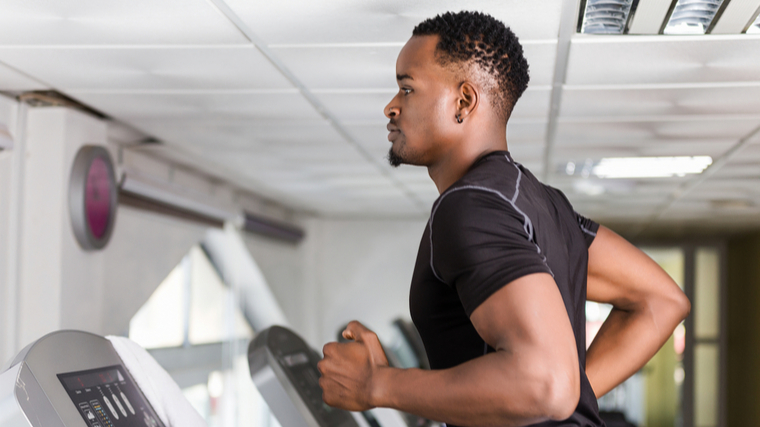You only have an hour to dedicate to your gym time today, and you want to spend the bulk of it actually working out. Although you might not want to, you know that warming up properly is essential for increasing your workout’s effectiveness and safety — so you’ve already dedicated at least ten minutes to that. You’re tempted to pump the gas hard until the moment you have to leave the gym — but should you? Do you really have to cool down before you grab your bag and start crushing your post-workout shake?
There are a lot of ways to cool down after a workout — including heating yourself up in a sauna or dunking yourself in a cold water plunge. But cooling down is also about the active recovery that can immediately follow your lifts. Think moves like jogging, stretching, or otherwise moving your body to reacclimate to your post-exercise heart rate and body needs.

Figuring out what kind of cool-down to integrate into your program — if you even want to perform them at all — is an important part of figuring out how to prioritize your time in the gym. It’s going to come down to what matters most to you as a lifter, which may well be informed by what science says about cool-downs.
What is a Cool-Down?
A post-workout cool-down refers to a myriad of strategies to bring your body back to equilibrium after a training session. You might opt for stretching, jogging, low-intensity cycling or swimming, cold water immersion, or even sitting in a sauna.
Cooling down is meant to reorient your body to a post-workout reality, in which you’re going about your daily activities instead of lifting heavy weights. While research suggests that cool-downs don’t quite do everything many athletes assume they do, they efficiently lower your heart rate and can add sustainable levels of cardio to your routine. Plus, if you enjoy your particular cool-down ritual, you’re more likely to perform well in future workouts. (1)(2)(3)
Benefits of Cooling Down
Cool-downs are widely thought to be able to do pretty much anything — prevent muscle soreness, hasten your recovery after an intense session, and make you more flexible. And while the science doesn’t necessarily verify all of that, there are some pretty solid benefits of cool-downs you’ll want to consider before dismissing them.
Feel Better, Perform Better
If you like cooling down, chances are you’ll feel better after you do it. Athletes often enjoy stretching after a workout because it allows them the space and time to relax, reflect on their training session or competition, and even socialize. (4)

Enjoying the process might just make all the difference in terms of having an effective cool-down. Regardless of the physiological benefits of a particular mode of recovery, athletes are known to perform better when they feel like they’ve recovered well. (1)(2)(3)
Heart Rate Recovery
When your heart is thumping wildly after an intense training session, bringing it back down is one of the principle goals of a cool-down. Performing an active cool-down lowers your heart rate more efficiently than passive recovery. (5)
Muscle Recovery
Active recovery sessions performed right after intense workouts have been shown to be more effective than passive recovery at clearing creatine kinase (CK) from your bloodstream. (6) CK levels are an indirect sign of muscle damage and may need to be reduced for your muscles to heal — active recovery right after exercise seems to help with that.
Added Cardio (That Won’t Negatively Impact Your Gains)
Yes, you can have cardio in your program without messing up your muscle mass or strength levels. Cooling down with a moderate-intensity, 15-minute jog does not interfere with long-term gains for well-trained athletes. (7)

This means that, with significant experience under your belt, you can safely add cardio into your training routine without negatively impacting strength. And when you have better cardio health, you’re more likely to have the stamina you need to bust through longer, harder workouts (which, in turn, makes you stronger).
Limits of Cooling Down
Sure, they have plenty of benefits. But all the things people think about cool-downs aren’t necessarily true.
Cool-downs don’t seem to reduce delayed-onset muscle soreness, even though many people assume that they do. (8) However, believing that they do might just be able to help you recover better for your next training session, anyway. (1)(2)(3)
People often think that cool-downs help make you more flexible — but science doesn’t necessarily support that. It’s been shown that active cool-downs performed in a pool do not necessarily increase ankle, hamstring, or hip ranges of motion after exercise (9).

A low-intensity 12-minute run, alongside eight minutes of lower limb static stretching — typical of many cool-down routines — has been shown to have no significant impact on stiffness nor range of motion after 45 minutes of exercise. (10) That said, cooling down hasn’t been shown to hurt mobility or flexibility levels, so there’s no reason to avoid stretching out if it feels good after your session.
How to Cool Down After a Workout
After your workout, choose a mode of active recovery that you genuinely enjoy. Maybe that’s cold water immersion, jogging, or stretching. If your chosen form of active recovery feels like “more work,” the less effective it’ll be at helping you feel better after a workout. (11) When you pick something you like and create a cool-down ritual with it, you’re less likely to feel like cooling down is just something else burdensome to tack onto your program when you’re fatigued.
Try to think about your cool-down as a transition out of the gym and back into the rest of your day. What do you need to effectively make that happen? A jog or cold plunge to clear your head? Some long, meditative minutes of stretching?

You’ll also want to assess what your program is currently lacking. The end of your workout can be a great time to work on any shortcomings in your program. Want to integrate some cardio work but don’t want to impede your recovery? Plug some into your cool-down. Need to practice integrating consistent mobility exercises into your routine? Program a stretch-focused cool-down. Want to add some meditative stretching or clear your head by doing some deep breathing in a sauna? Plan your cool-down accordingly.
Sample Workout Cool-Downs
What kind of cool-down you do will definitely depend on what you have access to and what you like. Don’t have access to a pool? You probably won’t be programming swimming as a mode of active recovery after a workout. On the other hand, even if you have access to a treadmill, you might only want to program post-exercise jogging if you don’t completely hate it. Here are some ways to get creative with your cool-down.
After Weight Training
When you’ve finished with your regularly-scheduled session of crushing weights and you’re ready to cool down, you might want to even out your session with a bit of light cardio. Count on intense sets of five by fives to spike your heart rate — a short, low-intensity cardio session can help your body ease back into your regular day-to-day.
- Three-minute walk
- Twelve-minute jog OR 1,000-meter row
Take all of these activities at a slow pace, thinking more about evening out your breathing rather than revving it up. If you’re really not used to doing any kind of cardio, cut these prescriptions in half. You can even slice them down by a quarter, and work your way up as needed or desired.
After Intense Cardio
Finishing up an intense cardio session can make catching your breath particularly rough. Whether you’ve just run sprints, decided to go all out on an air bike, or HIIT your way through box jumps and burpees, you’ve got to catch your breath somehow. Since you’ve already gotten in your cardio for the day, try something a little more soothing for your cool down.
- Slow Jog or Row: 4 minutes
- Cat-Cow: 2×10 breaths
- Three-Way Hip Openers: 2×5 per direction
- Downward Dog with Calf Marches: 3×15 marches per side
- Plank Thoracic Opener: 2×10 per side
After Maxing Out
Did you put in a max effort today? Maybe that means heavy doubles and triples, or maybe that means you literally maxed out with PR efforts. When you’ve put yourself through such a Herculean effort, you’ll want to go extra easy on your body as your cool-down.
- Slow walk: 5 minutes
- Cold Plunge or Sauna: 15 minutes
Cool It
If you like cooling down, you can make it work for you. Cooling down might not make you less sore on a physiological level, but that doesn’t mean it can’t help your recovery. Experiment with modes of post-workout active recovery that you enjoy so that you can feel better after your workout. Because when you feel better about your routine, you’re more likely to come back stronger — and that’s what your cool-down is all about.
References
- Cook CJ, Beaven CM. Individual perception of recovery is related to subsequent sprint performance. Br J Sports Med. 2013 Jul;47(11):705-9.
- Saw AE, Main LC, Gastin PB. Monitoring the athlete training response: subjective self-reported measures trump commonly used objective measures: a systematic review. Br J Sports Med. 2016;50(5):281-291.
- Raeder, Christian, et al. “Effects of active recovery on muscle function following high-intensity training sessions in elite Olympic weightlifters.” Adv Skelet Muscle Funct Assess 1.1 (2017): 3-12.
- Crowther F, Sealey R, Crowe M, Edwards A, Halson S. Team sport athletes’ perceptions and use of recovery strategies: a mixed-methods survey study. BMC Sports Sci Med Rehabil. 2017;9:6.
- Takahashi T, Okada A, Hayano J, Tamura T. Influence of cool-down exercise on autonomic control of heart rate during recovery from dynamic exercise. Front Med Biol Eng. 2002;11(4):249-59.
- Gill ND, Beaven CM, Cook C. Effectiveness of post-match recovery strategies in rugby players. Br J Sports Med. 2006;40(3):260-263.
- Van Hooren B, Peake JM. Do We Need a Cool-Down After Exercise? A Narrative Review of the Psychophysiological Effects and the Effects on Performance, Injuries and the Long-Term Adaptive Response. Sports Med. 2018;48(7):1575-1595.
- Crowther F, Sealey R, Crowe M, Edwards A, Halson S. Influence of recovery strategies upon performance and perceptions following fatiguing exercise: a randomized controlled trial. BMC Sports Sci Med Rehabil. 2017;9:25.
- Takahashi J, Ishihara K, Aoki J. Effect of aqua exercise on recovery of lower limb muscles after downhill running. J Sports Sci. 2006 Aug;24(8):835-42.
- Rey E, Lago-Peñas C, Casáis L, Lago-Ballesteros J. The effect of immediate post-training active and passive recovery interventions on anaerobic performance and lower limb flexibility in professional soccer players. J Hum Kinet. 2012 Mar;31:121-9.
- Crowther F, Sealey R, Crowe M, Edwards A, Halson S. Influence of recovery strategies upon performance and perceptions following fatiguing exercise: a randomized controlled trial. BMC Sports Sci Med Rehabil. 2017;9:25.
Featured Image: oneinchpunch / Shutterstock